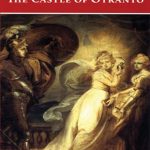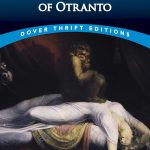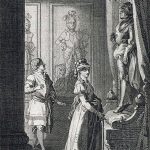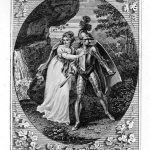The Castle of Otranto
The Castle of Otranto is a book by Horace Walpole first published in 1764 and generally regarded as the first gothic novel. In the second edition, Walpole applied the word ‘Gothic’ to the novel in the subtitle – “A Gothic Story”. The novel merged medievalism and terror in a style that has endured ever since. The aesthetic of the book has shaped modern-day gothic books, films, art, music and the goth subculture.
Plot
The Castle of Otranto tells the story of Manfred, lord of the castle, and his family. The book begins on the wedding-day of his sickly son Conrad and princess Isabella. Shortly before the wedding, however, Conrad is crushed to death by a gigantic helmet that falls on him from above. This inexplicable event is particularly ominous in light of an ancient prophecy, “that the castle and lordship of Otranto should pass from the present family, whenever the real owner should be grown too large to inhabit it”. Manfred, terrified that Conrad’s death signals the beginning of the end for his line, resolves to avert destruction by marrying Isabella himself, while divorcing his current wife, Hippolita, who he feels has failed to bear him a proper heir due to the sickly condition of Conrad before his untimely death.
However, as Manfred attempts to marry Isabella, she escapes to a church with the aid of a peasant named Theodore. Manfred orders Theodore’s death while talking to the friar Jerome, who ensured Isabella’s safety at the church. When Theodore removes his shirt to be killed, Jerome recognizes a marking below his shoulder and identifies Theodore as his own son. Jerome begs for his son’s life, but Manfred says Jerome must either give up the princess or his son’s life. They are interrupted by a trumpet and the entrance of knights from another kingdom, who want to deliver Isabella. This leads the knights and Manfred to race to find Isabella.
Theodore, having been locked in a tower by Manfred, is freed by Manfred’s daughter, Matilda. He races to the underground church and finds Isabella. He hides her in a cave and blocks it to protect her from Manfred and ends up fighting one of the mysterious knights. Theodore badly injures the knight, who turns out to be Isabella’s father, Frederic. With that, they all go up to the castle to work things out. Frederic falls in love with Matilda and he and Manfred begin to make a deal about marrying each other’s daughters. Manfred, suspecting that Isabella is meeting Theodore in a tryst in the church, takes a knife into the church, where Matilda is meeting Theodore. Thinking his own daughter is Isabella, he stabs her. Theodore is then revealed to be the true prince of Otranto as Matilda dies, leaving Manfred to repent. He abdicates the principality and retires to religion along with Hippolita. Theodore becomes prince and is married to Isabella, for she is the only one who can truly understand his sorrow.
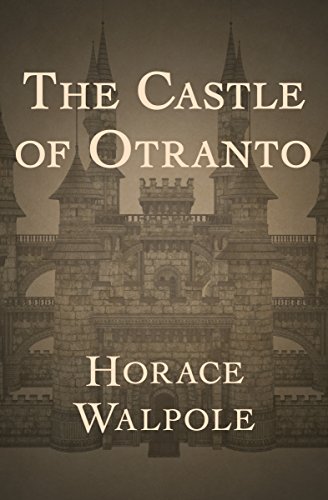
Horace Walpole
Horace Walpole
1764
Republish Covers
History
The Castle of Otranto was written in 1764 during Horace Walpole’s tenure as MP for King’s Lynn. Walpole was fascinated with medieval history, building in 1749 a fake gothic castle, Strawberry Hill House.
The initial edition was titled in full: The Castle of Otranto, A Story. Translated by William Marshal, Gent. From the Original Italian of Onuphrio Muralto, Canon of the Church of St. Nicholas at Otranto. This first edition purported to be a translation based on a manuscript printed at Naples in 1529 and recently rediscovered in the library of “an ancient Catholic family in the north of England”. This “ancient Catholic family” is possibly the Percy family, as Walpole would have known the Duke of Northumberland and his wife Elizabeth Percy, though this is not proven. He employed an archaic style of writing to further reinforce this.
The Italian manuscript’s story, it was claimed, derived from a story still older, dating back perhaps as far as the Crusades. This Italian manuscript, along with alleged author “Onuphrio Muralto”, were Walpole’s fictional creations, and “William Marshal” his pseudonym.
In the second and subsequent editions, Walpole acknowledges authorship of his work, writing: “The favourable manner in which this little piece has been received by the public, calls upon the author to explain the grounds on which he composed it” as “an attempt to blend the two kinds of romance, the ancient and the modern. In the former all was imagination and improbability: in the latter, nature is always intended to be, and sometimes has been, copied with success…”. There was some debate at the time about the function of literature; that is, whether works of fiction should be representative of life, or more purely imaginative (i.e. natural vs. romantic). The first edition was well received by some reviewers who understood the novel as belonging to medieval fiction, “between 1095, the era of the First Crusade, and 1243, the date of the last”, as the first preface states; and some referred to Walpole as an “ingenious translator”. Following Walpole’s admission of authorship, however, many critics were loath to lavish much praise on the work and dismissed it as absurd, fluffy, romantic fiction, or even unsavory or immoral.
In his 1924 edition of The Castle of Otranto, Montague Summers showed that the life story of Manfred of Sicily inspired some details of the plot. The real medieval castle of Otranto was among Manfred’s possessions.
Impact and adaptations
Literary
Otranto is generally credited with creating the entire Gothic novel genre. It was a smash hit in its day, until the author revealed that it was purely satirical fiction rather than an actual adaptation of medieval text. At that point, the critics and populace who had praised it turned on the book, claiming it was superficial, and other pejoratives generally assigned to romantic novels, which were seen as inferior in Britain at that time. But its impact was dramatic. The novelist Clara Reeve wrote The Old English Baron as a response, claiming she was taking Walpole’s plot and adapting it to the demands of the time by balancing fantastic elements with 18th-century realism. She explained:
This Story is the literary offspring of The Castle of Otranto, written upon the same plan, with a design to unite the most attractive and interesting circumstances of the ancient Romance and modern Novel. The question now arose whether supernatural events that were not as evidently absurd as Walpole’s would not lead the simpler minds to believe them possible.
After a number of other novels were added to the budding Gothic genre, the teenage author Matthew Lewis published The Monk, a novel that directly imitated the formula of Otranto, but took it to such an extreme that some have interpreted the novel as parody.
Film adaptations
Jan Švankmajer directed the surrealist short film Castle of Otranto (1979) based on the novel. It took the form of a pseudo-documentary frame story in live action with an abridged adaptation of the story itself presented in cut-out animation in the style of Gothic art.
Artwork
- Print, engraving, Isabella and Theodore from The Castle of Otranto by Horace Walpole
